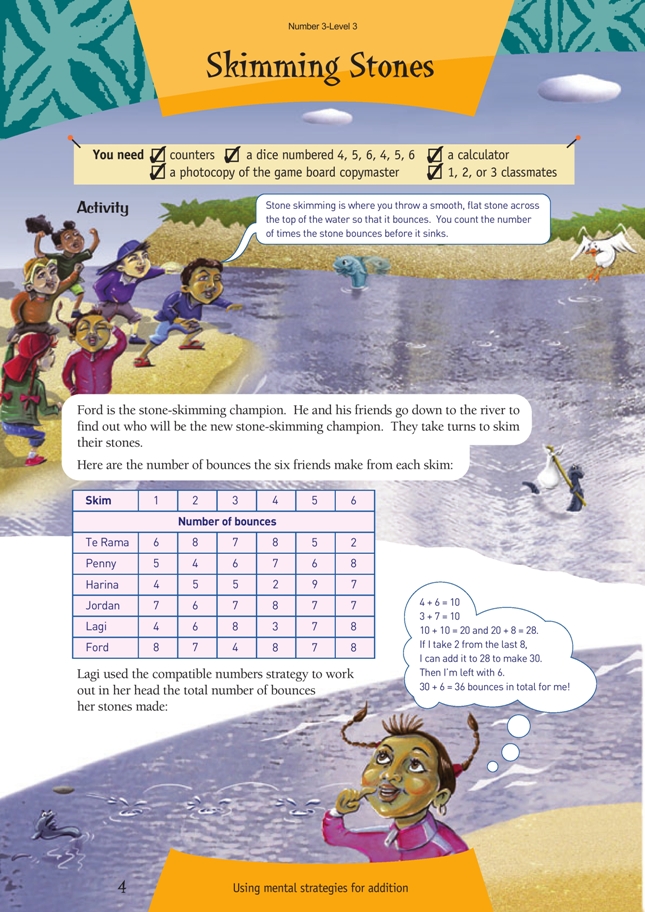This is a level 3 number activity from the Figure It Out series. It relates to Stage 6 of the Number Framework.
A PDF of the student activity is included.
Click on the image to enlarge it. Click again to close. Download PDF (362 KB)
use compatible numbers to solve addition problems
find the mean of a set of members
Counters
A dice numbered 4,5,6,7,8, and 9
FIO, Level 3, Number, Book 3, Skimming Stones, pages 4-5
1,2, or 3 classmates
Calculator
To do this activity, students need to know what a “mean” is (a reminder is given on the page). They will use it in the game, but they may also decide to use the mean as a way of finding the new champion in the activity. For the game, students also need to understand rounding.
Two major concepts are encouraged on the page: finding various mental strategies to add a series of numbers and developing an understanding of what an average (mean) is. The activity shows how the strategy of compatible numbers and making sets of 10 can be used and asks the students to use other strategies to find the total. These strategies could include using basic facts (up to and including adding 9), using 5s instead of 10s, or “averaging the numbers” and multiplying by 6.
Jordan’s skim scores, 7, 6, 7, 8, 7, and 7, are very suitable for averaging the numbers, as shown in the Answers, but this strategy could also be applied to Penny’s (3 x 5 + 3 x 7) and Ford’s (6 x 7, with the extra 1 in each of the 8s being added to the 4).
Various answers and strategies are possible for question 2. After the students have finished the activity, encourage them to share their strategies with a group of classmates. Some suggestions are given in the Answers.
Some students may already have suggested the strategies in questions 3 and 4 as a way of determining the new champion, but they still need to apply these strategies and, in the case of question 4, to justify their answer.
Game
A copymaster for the game is provided at the end of these notes. To find their score for each turn, the students need to calculate the mean. They could add the numbers and divide by the number of counters, but if they find division difficult, they could use the strategy of averaging out the numbers and multiplying by the number of skims, as suggested for question 1. For example, for skim scores of 9, 7, 7, and 4, take 2 from the 9 and add it to the 4. This now makes 7, 7, 7, and 6, so a realistic mean is 7. The students can use a calculator to check the mean. At times, the calculator check will display decimal fraction numbers, so you may need to discuss how to round
numbers to the nearest whole number. The game requires the students to “flick” counters, so it would also be appropriate to discuss the correct behaviour for playing the game.
Further discussion and investigation
The students could practise using other students’ mental strategies for adding a set of numbers. Ask them: “Would you need to change the strategy if the numbers included tens and/or hundreds? How would you do this?”
Discuss the various ways of finding the “champion” and see if the group or class can come to a consensus as to the fairest way.
The students could investigate sports in which the worst score is eliminated, for example, diving. (See also Number: Book Three, Figure It Out, Levels 3–4, pages 2–3, for an activity in which lowest scores are discarded.)
Answers to Activity
1. Possible strategies include:
• looking for compatible numbers, as Lagi did
• adding the numbers in groups of 2
(4 + 6 = 10, 8 + 3 = 11, 7 + 8 = 15, 10 + 11 + 15 = 36)
• using basic facts (4 + 6 = 10, 10 + 8 = 18, 18 + 3 = 21, 21 + 7 = 28, 28 + 8 = 36)
• averaging the numbers and multiplying by 6
(the 6 and 8 in Jordan’s scores can be seen as two 7s, and 6 x 7 = 42).
The total number of bounces for each person is:
Te Rama: 36; Penny: 36; Harina: 32; Jordon: 42; Lagi: 36; and Ford: 42.
2. Answers will vary. For example, you could take the 4 best skims of the two leading contenders (Jordan and Ford have the same total for 6 skims), you could find the mean of each person’s skims, or you might decide that Harina is the new champion because she was the only one to have a skim with 9 bounces.
3. Ford. (38, compared to Jordan’s 36)
4. Jordan. 4 of his 6 skims had 7 bounces, and the other 2 skims had close to 7.
Game
A game for using mental strategies for addition

